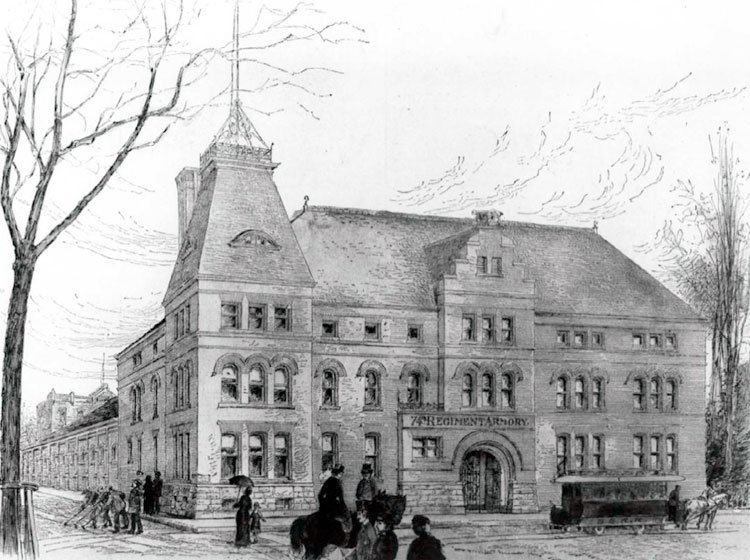by Kelly Hayes McAlonie, FAIA, LEED AP
Photo credit: Wikimedia
Louise Blanchard Bethune was the first woman to practice as a professional architect in the United States. She participated in the design of approximately 180 buildings in the Buffalo and New England areas in the late nineteenth and early twentieth centuries. The first woman member of the AIA and the first woman to be honored as an AIA Fellow, Bethune founded the AIA Buffalo/ Western New York Chapter.
Jennie Louise Blanchard was born on July 21, 1856 in Waterloo, NY to a family of educators. Louise was taught at home until aged 11, when she attended school in Buffalo, NY, after her family moved to the city. From girlhood she had an interest in architecture and designing houses. She later stated that a “caustic remark” made to her while in high school directed her attention to the study of architecture and “an investigation, which was begun in a spirit of playful self-defense, soon became an absorbing interest”. (1) After graduating from Buffalo High School in 1874 she spent two years preparing to attend the newly opened Cornell University architecture program. However, in 1876 she was offered a position as an apprentice at the office of Richard Waite, the most prominent architect in Buffalo, which she accepted. After five years of hard work and self-directed study she was ready to break out on her own.
In October, 1881 she opened her own practice. Former Richard Waite colleague, Robert Bethune, soon joined her and they were married in December of that year. In 1885, Louise Bethune applied for membership to the Western Association of Architects (WAA) and was unanimously elected. Bethune was immediately placed on the committee of the organization of State Associations, as the first and only member from New York State in the WAA. The following year, she and Robert organized the Buffalo Society of Architects (now AIA Buffalo/WNY), and she served as vice president and treasurer of the Chapter. In 1888, Bethune was the first woman elected to the American Institute of Architects. When the WAA and the AIA merged in 1889, Bethune became the AIA’s first woman fellow.
The firm designed houses, schools, police stations, factories and commercial buildings. Bethune took special interest in school design, probably because her parents were both teachers. Beginning in 1881, the Buffalo Public Schools District embarked upon an ambitious master plan under the direction of progressive Superintendent James Crooker. Bethune & Bethune Architects successfully competed with other more established firms. They designed 18 schools during the history of the firm. In 1893, Bethune noted that although she particularly enjoyed educational design, she did not specialize because she felt that it was her duty as the first professional woman architect to demonstrate capacity in all facets of architectural practice. In 1891, William Fuchs, their protégé and longtime draftsman, became the third partner, and the firm was renamed Bethune, Bethune & Fuchs Architects.
In 1891, Bethune was asked to submit a design for the women’s competition for the Women’s Building of the Columbia Exposition in Chicago. Such a commission was expected to catapult the career of its architect. Bethune refused to submit an entry because the winning fee was much lower than the commission fee for male architects of the other Exposition buildings. She stated:
“The idea of a separate Woman’s Board expresses a sense of inferiority that business women are far from feeling… It is unfortunate that it should be revived in its most objectionable form on this occasion by women and for women.” (2)
Bethune’s opportunity to create a nationally significant building came in the early 1900’s with the commission for the Lafayette Hotel. Located in downtown Buffalo, the seven story, 225 room Renaissance Revival hotel featured hot and cold water in all bathrooms and telephones in all rooms, was praised as “the best that science, art and experience can offer for the traveling public.” When it opened in 1904, it was considered one of the fifteen finest hotels in the country and was copied elsewhere. (3) An expansion was planned immediately after opening, which was also designed by Bethune, Bethune & Fuchs, which opened in 1912. Bethune supervised the construction of both the original building and the addition.
Bethune discontinued her AIA membership in 1904. She devoted her spare time in the last decade of her on the Buffalo Genealogy Club, the Buffalo Historical Society, the Daughters of the American Revolution, and the New England Historical Society. Louise Blanchard Bethune died on December 18, 1913 at the age of 57 and is buried in Forest Lawn Cemetery. Her obituary stated that she was particularly proud of her work on the Lafayette Hotel in Buffalo.
For more information, visit this website authored by our own Kelly Hayes McAlonie, FAIA:
https://pioneeringwomen.bwaf.org/louise-blanchard-bethune/
(1) Frances E Willard & Mary A. Livermore Woman of the Century (Buffalo: Moulton,, 1893), 81.
(2) Louise Bethune, “Women and Architecture,“ Inland Architect and News Record 17, no. 2 (1891).
(3) Torre, Women in American Architecture, 62.
Click each image to enlarge it.
Photo credits: Kelly Hayes McAlonie, used with permission.







